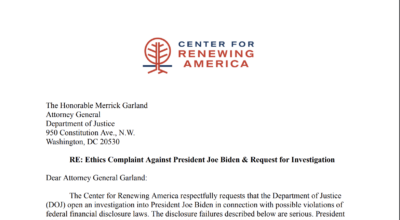
Primer: The Biden Expanded Child Tax Credit Furthers Dependency and Unemployment
Summary
The federal Child Tax Credit (CTC) has been a part of the U.S. tax code since the passage of the Taxpayer Relief Act of 1997. Since its creation, the credit has undergone numerous revisions and additions from federal lawmakers in both parties. However, the latest change to the CTC, courtesy of the Biden administration’s $1.9 trillion COVID relief package, completed the transformation of the credit into a direct welfare payment to some 39 million American households.
Many public policy experts and concerned citizens warned lawmakers that this monthly direct payment scheme, implemented under the guise of an emergency economic measure to overcome the damage wrought by COVID-19 and harmful lockdown policies, would cause more social and economic harm than good.
The expanded CTC benefits are scheduled to expire on December 31, 2021, at which point the original CTC will revert back. It is worth examining the original purpose of the credit and the impact of its most recent transformation.
Background: What Is the Child Tax Credit?
The CTC was initially structured as a $500-per-child nonrefundable credit that was targeted to middle-income taxpayers as a tax relief measure. Over the years, the credit has been modified and altered numerous times.
The first major change to the CTC occurred just four years after its creation with the passage of the Economic Growth and Tax Relief Reconciliation Act of 2001, the first of two major tax relief bills passed into law under former President George W. Bush. This legislation ratcheted up the amount of the CTC to $1,000-per-child and utilized a formula that mirrored that of the Earned Income Tax Credit (EITC) to remove some of the credit’s inherent means-testing. Specifically, the 2001 tax cut bill made the credit partially refundable, allowing it to exceed income tax liability. Over time, this excess became known as the additional child tax credit.
In 2009, amid the Great Recession and following the election of former President Barack Obama, Congress passed the American Recovery and Reinvestment Act. The “stimulus” bill set the income threshold for refundability to $3,000. This policy change expanded the CTC to those who previously had not qualified for it and altered the purpose of a credit originally designed to provide tax relief to middle-income households who bear the brunt of the nation’s tax burden.
In 2017, Congress passed yet another tax reform bill known as the Tax Cuts and Jobs Act. This legislation doubled the existing amount of the CTC from $1,000 to $2,000-per-child, lowered the income requirement for refundability from $3,000 to $2,500, and increased the maximum of the additional child tax credit for those with no income tax liability to $1,400 per child.
Furthermore, the 2017 tax bill increased the phaseout threshold of the CTC by nearly 400 percent, up from $110,000 per married filer to $400,000 per married filer. Additionally, the Tax Cuts and Jobs Act also created a “family credit” component of the CTC that included non-child eligible dependents and incorporated an anti-fraud provision that required taxpayers to provide Social Security numbers for every child used to claim the credit.
In championing the expanded credit in the Tax Cuts and Jobs Act, and in their calls for further expansion in recent years, Senators Marco Rubio (R-FL) and Mike Lee (R-UT) have consistently emphasized the importance of the 2017 credit’s income phase-in linking the benefit to payroll tax liability. This provision effectively served as a work requirement embedded in the credit’s design, preserving a policy distinction between tax relief and strings-free cash assistance.
The Biden Administration enacted critical changes to the CTC—frequently referred to as the expanded child tax credit—with passage of the $1.9 trillion American Rescue Plan Act of 2021. The legislation expanded the $2,000-per-child maximum to $3,600-per-child for children under the age of six and $3,000-per-child for children up to the age of 17. Furthermore, the American Rescue Plan eliminated the $2,500 income requirement to receive the credit, eliminated the $1,400-per-child cap on the additional child tax credit, and distributed half the total credit in the final six months of 2021 through direct payments, effectively eliminating the most significant means-testing provisions for a credit originally aimed at alleviating the tax burden on middle-income taxpayers.
The Biden Administration’s Build Back Better Act, whose programs, if made permanent, would cost $4.73 trillion according to the Congressional Budget Office (CBO), would indefinitely eliminate the work incentives within the credit and extend the increased $3,000 or $3,600-per-child credit for another full-year.
The analysis put forward by CBO also estimated that the expanded CTC enacted under the American Rescue Plan would increase deficits by $1.6 trillion over the next decade should the expanded CTC be made permanent.
The Expansion and Transformation of the Child Tax Credit
The longstanding structure of the CTC as originally designed increased benefits as households increased their earnings before the adjusted gross income thresholds gradually phased down the value of the credit. This pro-work incentive ensured that the majority of tax relief went to middle-income households serving as the backbone of America’s workforce.
The $1.9 trillion American Rescue Plan , however, eliminated the requirement that households earn at least $2,500 per year to be eligible to receive the credit, thereby eliminating pro-work incentives and morphing the CTC into what is essentially a direct cash welfare payment. The repeal of the $2,500 income requirement has been characterized as making the credit “fully refundable.” A more accurate description would be that this repeal changed the nature of the credit, as the CTC’s current incarnation bears very little resemblance to its original design and purpose.
Implications: Expanding and Reshaping the Child Tax Credit
The expanded CTC with its increased payments-per-child, monthly direct cash payments, and repealed work requirement is slated to expire on December 31, 2021. The “Build Back Better” reconciliation bill, among myriad other radical policies, proposes extending the expanded CTC for another full-year through the end of 2022 and permanently eliminating the work requirement for the credit.
Proponents of the expanded or advanced CTC argue that these changes are critical for “reducing child poverty” and have pushed studies suggesting the expanded CTC has already achieved that objective. Some left-leaning economists, through the National Academy of Sciences, released a publication in 2019 suggesting that eliminating the income threshold in the CTC and removing the work requirements would have the largest impact on reducing child poverty while only costing 150,000 jobs. This study served as the primary data source for policymakers who implemented the expanded CTC in the American Rescue Plan. The study continues to be a primary source for those working to make the expanded CTC permanent.
Indeed, the progressive Center for Budget and Policy Priorities used the NAS Roadmap study to argue that making the expanded CTC provisions permanent would reduce child poverty by 40 percent at only a “modest” fiscal cost while having virtually no impact on reducing employment. These claims have, unsurprisingly, come under scrutiny.
Despite the expanded and advanced CTC being billed as “temporary” pandemic relief by its backers throughout 2021, liberal voices wasted little time in advocating permanent repeal of the work requirements and permanent extension of the increased credit beyond the end of the 2021 calendar year. Such changes would fundamentally transform the CTC into a program akin to “universal basic income” for households with children. Despite proponents’ stated intentions, by weakening incentives to enter the workforce, these changes would actually undermine efforts to significantly reduce child poverty in comparison to other means-tested welfare programs .
Economists at the University of Chicago released a detailed paper in October 2021 challenging the analysis of the NAS study and the data pushed by proponents of these changes to the CTC. Their analysis revealed that the NAS study had failed to incorporate the substitution effect of the expanded CTC, thereby rendering its job loss calculations off by an astronomical 1000 percent. This revelation resulted in a rare formal letter sent by these economists to NAS requesting the Academy correct the data errors in their Roadmap publication.
Furthermore, opponents have pointed out that low-income households already have access to myriad federal welfare programs including the Supplemental Nutrition Assistance Program (SNAP), more commonly known as food stamps, federal housing subsidies, the EITC, and Medicaid.
The ongoing dispute in the economics field over the expanded CTC comes amid other economic challenges potentially exacerbated by the reconciliation bill. Indeed, Americans are experiencing near-record inflation with year-over-year inflation up 6.8 percent in November. The national debt continues its rapid rise to nearly $30 trillion, nearly 50 percent higher than the entire U.S Gross Domestic Product. The implementation of a new permanent welfare program, which formerly had been a means-tested credit constructed to offset the tax burden on working families, would almost assuredly have negative impacts on both the short- and long-term fiscal outlook.
Policymakers should bear in mind several key concerns raised by making the expanded CTC permanent:
- Total Cost: CBO estimates that the permanent expansion of the CTC would increase deficits by $1.6 trillion over the next decade. The expanded CTC is also likely to exacerbate the rapid increase in inflation impacting American households.
- Employment: The study issued by University of Chicago economists revealed that the impact of making the expanded CTC permanent would be an astounding 1.5 million lost jobs as low-income workers with children, many of whom already are eligible for myriad means-tested federal welfare programs, would forgo employment in favor of the expanded CTC’s “universal basic income.” By contrast to the Build Back Better cash grant to non working households, conservative proposals to provide parents greater tax relief from Senators Rubio, Lee, and Hawley have consistently emphasized work by including household earnings thresholds to qualify families for support.
- Work Sentiment: According to Robert Rector, one of the foremost scholars on welfare reform, making full refundability permanent would result in an average per-child benefit for a family working 40 hours per week of $218 while the average per-child benefit for a family not working at all would be $1,775, nearly nine times higher. This suggests the policy would be a significant deterrent to pro-work sentiment among lower-income populations.
- Labor Shortages: The U.S. is currently experiencing a significant labor shortage. Current estimates suggest there are nearly 11 million job openings compared to 6.9 million unemployed Americans still seeking work. This massive gap can be attributed to a number of factors including fear of the COVID-19 virus, federal largesse through direct stimulus payments, increased unemployment benefits, and expanded welfare programs since the pandemic began. Making the expanded CTC permanent is likely to further contribute to this continued gap in labor supply, further increasing the economic strain on employers.
Concluding Assessment
Permanently transforming a means-tested tax credit into a direct payment welfare program will fuel continued government dependency, exacerbate labor shortages, and likely have a significant long-term negative impact on employment. This is a poorly conceived policy that would lay the groundwork for a socialist-inspired “universal basic income” for lower-income households with children and become yet another poverty trap engineered by central planners in Washington D.C.
The expanded CTC is slated to expire at the end of 2021. When that occurs, the previous incarnation of the CTC will be restored, bringing back important income requirements for refundability and reverting many of the policies that have transformed the credit into a cash grant welfare program. For the long-term health of our workforce and communities, as well as the long-term fiscal health of our republic, lawmakers should allow this to occur and resist efforts to make the expanded CTC permanent.



